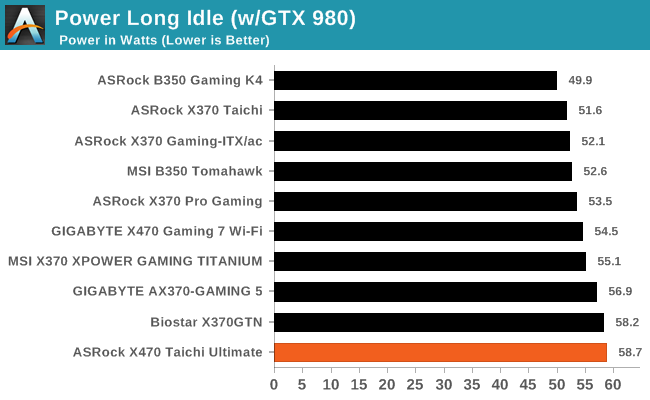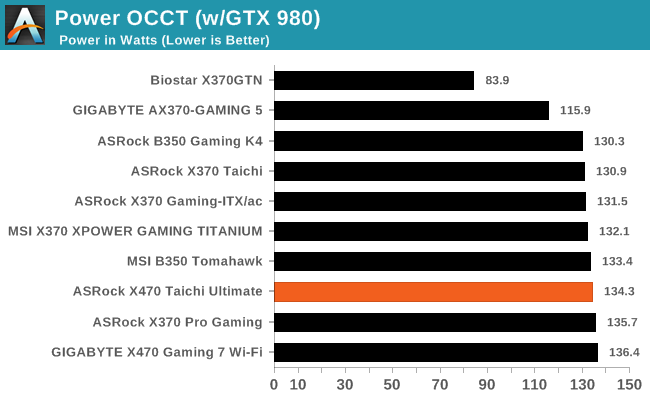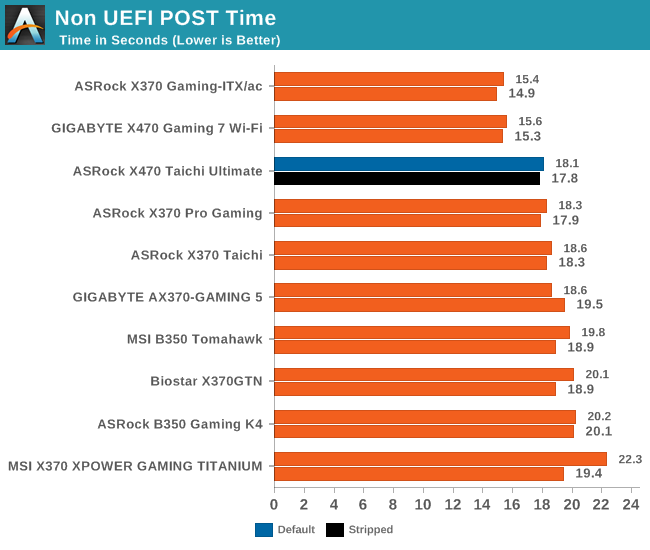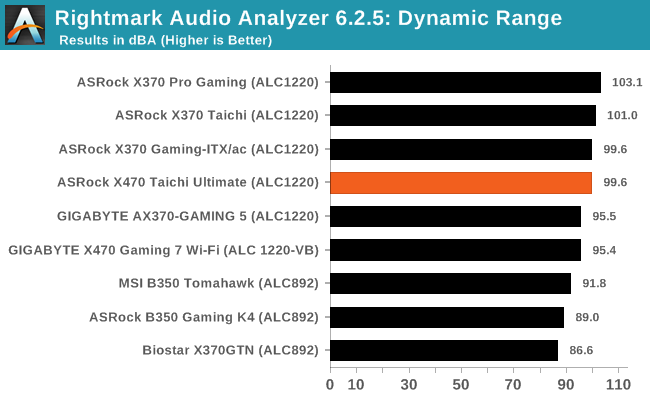The ASRock X470 Taichi Ultimate Motherboard Review: Aquantia 10GbE on Ryzen
by Gavin Bonshor on August 2, 2018 9:00 AM ESTSystem Performance
Not all motherboards are created equal. On the face of it, they should all perform the same and differ only in the functionality they provide - however, this is not the case. The obvious pointers are power consumption, but also the ability for the manufacturer to optimize USB speed, audio quality (based on audio codec), POST time and latency. This can come down to manufacturing process and prowess, so these are tested.
Power Consumption
Power consumption was tested on the system while in a single ASUS GTX 980 GPU configuration with a wall meter connected to the Thermaltake 1200W power supply. This power supply has ~75% efficiency > 50W, and 90%+ efficiency at 250W, suitable for both idle and multi-GPU loading. This method of power reading allows us to compare the power management of the UEFI and the board to supply components with power under load, and includes typical PSU losses due to efficiency. These are the real world values that consumers may expect from a typical system (minus the monitor) using this motherboard.
While this method for power measurement may not be ideal, and you feel these numbers are not representative due to the high wattage power supply being used (we use the same PSU to remain consistent over a series of reviews, and the fact that some boards on our test bed get tested with three or four high powered GPUs), the important point to take away is the relationship between the numbers. These boards are all under the same conditions, and thus the differences between them should be easy to spot.



The ASRock X470 Taichi Ultimate on the whole uses less power at load than the X470 Gaming 7 Wi-Fi, but at idle states, consumes the most power out of all the AM4 boards tested with our Ryzen 7 1700 processor. Perhaps a consequence of having so many additional controllers and including 10G Ethernet, although not much variance and nothing too much to worry about given that this model is targeted at enthusiasts.
Non-UEFI POST Time
Different motherboards have different POST sequences before an operating system is initialized. A lot of this is dependent on the board itself, and POST boot time is determined by the controllers on board (and the sequence of how those extras are organized). As part of our testing, we look at the POST Boot Time using a stopwatch. This is the time from pressing the ON button on the computer to when Windows starts loading. (We discount Windows loading as it is highly variable given Windows specific features.)

The Taichi Ultimate does POST quite fast, beats all but the X370 Gaming-ITX/ac from their X370 range, and the previously reviewed X470 Gaming 7 Wi-Fi from GIGABYTE. Disabling the onboard controllers displayed a very negatable 0.3s variance in POST time.
Rightmark Audio Analyzer 6.2.5
Rightmark:AA indicates how well the sound system is built and isolated from electrical interference (either internally or externally). For this test we connect the Line Out to the Line In using a short six inch 3.5mm to 3.5mm high-quality jack, turn the OS speaker volume to 100%, and run the Rightmark default test suite at 192 kHz, 24-bit. The OS is tuned to 192 kHz/24-bit input and output, and the Line-In volume is adjusted until we have the best RMAA value in the mini-pretest. We look specifically at the Dynamic Range of the audio codec used on the rear panel of the board.

The X470 Taichi Ultimate performs consistent with other boards featuring a Realtek ALC1220 audio codec in our RMAA 6.2.5 Dynamic Range testing. Even though the board features no element of isolation shileding on the codec or any visible audio PCB seperation, it shows good and able results.
DPC Latency
Deferred Procedure Call latency is a way in which Windows handles interrupt servicing. In order to wait for a processor to acknowledge the request, the system will queue all interrupt requests by priority. Critical interrupts will be handled as soon as possible, whereas lesser priority requests such as audio will be further down the line. If the audio device requires data, it will have to wait until the request is processed before the buffer is filled.
If the device drivers of higher priority components in a system are poorly implemented, this can cause delays in request scheduling and process time. This can lead to an empty audio buffer and characteristic audible pauses, pops and clicks. The DPC latency checker measures how much time is taken processing DPCs from driver invocation. The lower the value will result in better audio transfer at smaller buffer sizes. Results are measured in microseconds.

While none of the manufacturers of the boards tested on the AM4 socket so far have been optimized for DPC latency, the X470 Taichi Ultimate does pretty well considering and in comparison to others on test, it sits middle of the road.










41 Comments
View All Comments
LJM - Thursday, August 2, 2018 - link
Indeed I was. Thanks.Goty - Thursday, August 2, 2018 - link
So... no networking tests?PeachNCream - Thursday, August 2, 2018 - link
There's probably no equipment available to perform those tests. 10G switches and NICs aren't commonplace or affordable right now. Then again, Anandtech has done little in the way of network adapter testing and this article puts the network features of the board in question up as a headline feature, but does not quantify that feature in a comparative benchmark. That's a bit of a miss in my opinion and should be something rectified in the future.hansmuff - Thursday, August 2, 2018 - link
I would think a single 10G NIC would be enough, Startech sells one for $230. Pop that into any motherboard and at least do some simple iperf, "LAN Speed Test" or NetStress. Settle on one and use that going forward.DigitalFreak - Thursday, August 2, 2018 - link
No need to even spend that much. You can buy an Aquantia AQC107 NIC for $85.hansmuff - Thursday, August 2, 2018 - link
Huh, nice to know.. are there any 10 Gbps switches in a somewhat affordable range yet ($150-$200 4 port)?CheapSushi - Friday, August 3, 2018 - link
It's not 4 port but the cheap options are ASUS XG-U2008 & Netgear GS110MX. Also keep it mind you can direct connect two setups together say for a NAS to main rig without a switch. And the benefit of these newer switches and chips is that they're not finicky about what speed they're on; it's dynamic, so 10G, 5G, 2.5G, 1G and 100MB, etc.AdrianB1 - Thursday, August 2, 2018 - link
Good question, especially as mentioned the board is the Taichi plus the NIC, so the review is actually for the Taichi, not for Taichi Ultimate.LAN testing can be performed with another board with an Aquantia board with no switch, just a direct cable connection. And this board has also 2.5 and 5 Gbps capabilities, it would be interesting to see how well the real throughput scales: it depends a lot on how the chip is connected - how many lanes of which PCIe version. One needs 4x PCIe ver 2 or 2x PCIe ver 3 for full 10 Gbps, but there are not so many available PCIe lanes and the chip may be connected to half or a quarter of what it needs. That way you still get close to 5 Gbps one-way or even 8-9 Gbps one way, assuming the Aquantia chip can do that, but not full duplex 10 Gbps.
DigitalFreak - Thursday, August 2, 2018 - link
Unfortunately Asrock doesn't include a PCI-E diagram in their manual, so there's no way to know. It could be either PCI-E 2.0 x1, x2 or x4.Cygni - Thursday, August 2, 2018 - link
Its the same chipset and implementation that Aquantia has been selling on motherboards and add on cards for a while. That would be like testing the i211AT on the other port, its a pretty known quantity at this point.